10 Traditional Japanese Instruments: Features and Hands-on Workshops

Japanese traditional instruments have entertained and inspired people near and far for centuries! We introduce 10 musical instruments from shamisen to koto and Japanese flute, along with their sounds and features. Learn their differences and try one first-hand!
The heartbeat of Japan, traditional Japanese instruments are important cultural art forms that have inspired artists for centuries. Often used in performances to create an excellent storytelling atmosphere, these instruments have enchanted those who listen to their melodies, often igniting strong emotions and a sense of wonder and mystery.
In this article, we introduce 10 Japanese musical instruments you should know about, what makes them special, how they sound, and workshops where you can try them firsthand.
Traditional Japanese Instruments and Workshops
1. Japanese Traditional Instruments in Pop Culture:
2. Shamisen
3. Taiko Drums
4. Koto: 13-String Zither
5. Shakuhachi Flute
6. Sanshin
7. Kokyu
8. Sho
9. Tsuzumi Hand-Drum
10. Shinobue Flute
11. Biwa Lute
Japanese Traditional Instruments in Pop Culture
Japanese traditional instruments have left a significant imprint on pop culture, especially in the realms of anime, music, and contemporary rock and metal bands. Numerous anime series effectively incorporate these instruments into their soundtracks, enhancing narratives and evoking deep emotional responses. For instance, Mushishi features the haunting tones of the shamisen and other traditional instruments, creating an atmospheric and reflective experience that complements the story's themes of nature and spirituality. Additionally, Naruto richly integrates traditional music, featuring instruments like the shamisen and taiko drums to elevate the emotional stakes during critical moments of the story.
On the music front, many Japanese rock and metal bands creatively fuse traditional elements into their sound. Bands like Wagakki Band exemplify this fusion, combining the vigor of rock with the distinct tones of the shamisen, koto, and taiko drums, resulting in a dynamic and powerful sound that captivates audiences across generations. This harmonious blend of old and new showcases the versatility and enduring allure of Japanese traditional instruments within contemporary pop culture.
1. Shamisen
From modern-day pop and rock tunes to kabuki theater and folk music, the shamisen is an incredible instrument that can be used diversely across multiple genres! Originally from China, Japan welcomed the shamisen around the 16th century, and it has been a hit ever since.
The instrument is made from wood and animal skin, featuring three strings that stretch along its long neck, a square hollow base, and three large wooden tuners called a tenjin. There are three types of shamisen based on the width of the neck.

Photo by Pixta
Artists use one hand to hold down the cords along the neck of the instrument while the other hand uses a large rectangular plectrum to pluck the cords on the instrument's base, similar to playing the guitar.
Aomori Prefecture's Tsugaru City is particularly famous for its Tsugaru shamisen culture, which gave birth to world-renowned artists such as the Yoshida Brothers. There is even a Tsugaru Shamisen World Cup held every year in May for two days in Hirosaki. You can learn more about Tsugaru shamisen culture on the official website Amazing Aomori.
One notable anime that prominently features the shamisen in its soundtrack is Dororo. This series incorporates traditional Japanese music elements, including the shamisen, to enhance its historical and emotional storytelling. The soundtrack helps to create a deeply immersive atmosphere that complements the themes of loss, redemption, and the struggle between good and evil throughout the series.
2. Taiko Drums
The heartbeat of festivals! With a history of over 1,400 years in Japan, taiko or wadaiko is a type of drum that can be heard through a wide range of events and entertainment. From the thundering, rolling drums heard at epic festivals and used for intimidation and commands in intense historical battles, to the echoing taiko drums used to purify Shinto rituals, these drums have ignited passion, bravery, and power in the Japanese spirit for centuries.
The instrument features long wooden drumsticks, a large wooden barrel used as the base, and stretched animal skin attached with nails to both ends of the barrel.
These instruments are easily recognizable by their strong, chest-thumping boom. Visitors can hear them at festivals and taiko drum performances and even try them out at certain workshops. A great workout for those interested, visitors can also seek out the famous arcade machine called Taiko no Tatsujin in arcades.

Picture courtesy of Free Plus Co., Ltd.
DRUM TAO is one of the famous contemporary performer units focusing on taiko drum music. You can enjoy their performances at the Open-Air Theater TAO-no-Oka located within the Aso Kuji National Park in Kyushu, or during one of their national tours when they perform on stages in major cities.
Read also
3. Koto
The koto, often called the Japanese harp, is a hypnotic string instrument that, when played, creates high-pitched, mysterious melodies. Dating back to the Nara period (719-784), the koto typically has 13 strings, though there have been kotos known to have 20 strings. This instrument comes in four different types: gakuso, chikuso, zokuso, and tagenso.
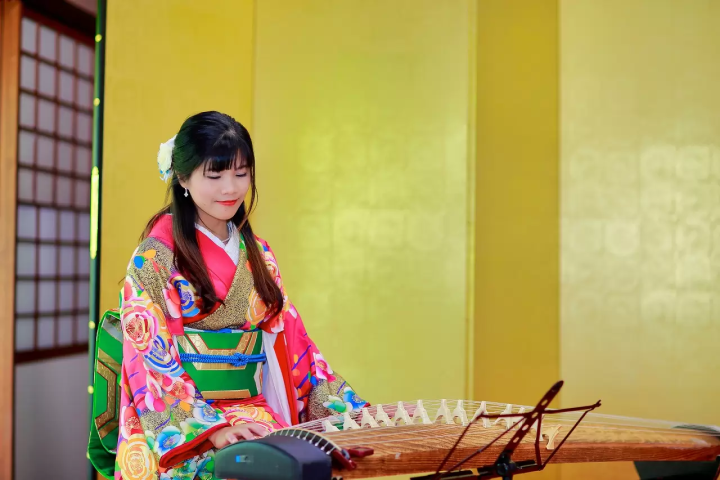
Photo by Pixta
Similar to a harp, musicians pluck the strings while sitting down to create melodies. Koto players use one hand with three small plectra clipped onto the end of their fingers and hold down the strings with the other hand, similar to playing a guitar, to help create a song. The sound the koto produces is full of charm; when you hear it, you can't help but feel like it is telling a story.
Fukuyama, a city in Hiroshima Prefecture, is renowned for producing koto instruments.
4. Shakuhachi
Known for its haunting, eerie sound, the shakuhachi is a wind instrument beloved in Japan and often featured in various music genres such as folk and contemporary music. The sound is commonly used in Zen meditation music and traditional Japanese music, reflecting its introduction to Japan through Buddhism from China in the 7th century.
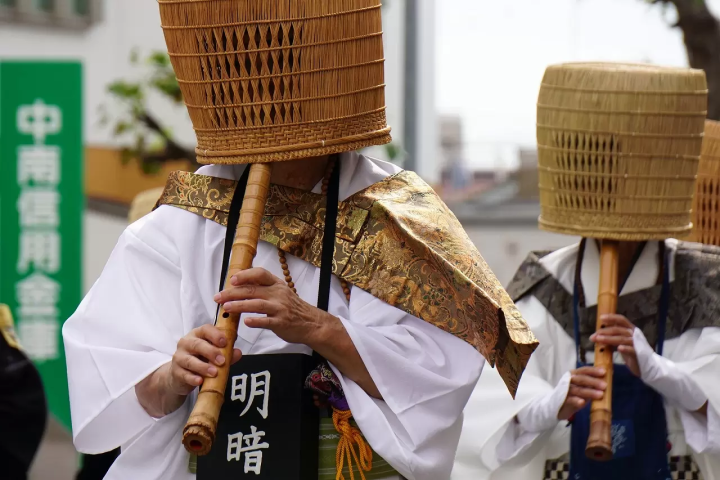
Photo by Pixta
The shakuhachi flute, traditionally made from the roots of Madake bamboo, is easily recognizable by its bamboo-like appearance, gently tapering towards the end of the instrument. On the front of the body are five holes, with one on the back where the player's thumb is placed. Musicians control the instrument's airflow by utilizing air from their lungs and manipulating their fingers over the instrument's holes.
5. Sanshin
The sanshin, not to be confused with the shamisen, is a small instrument that resembles the shamisen in design, but there are notable differences between the two. Originating from Okinawa, the sanshin is much smaller in size compared to its counterpart. It is a banjo-like instrument featuring a long neck, three strings, and a circular hollow base made from a coconut shell wrapped in snakeskin.
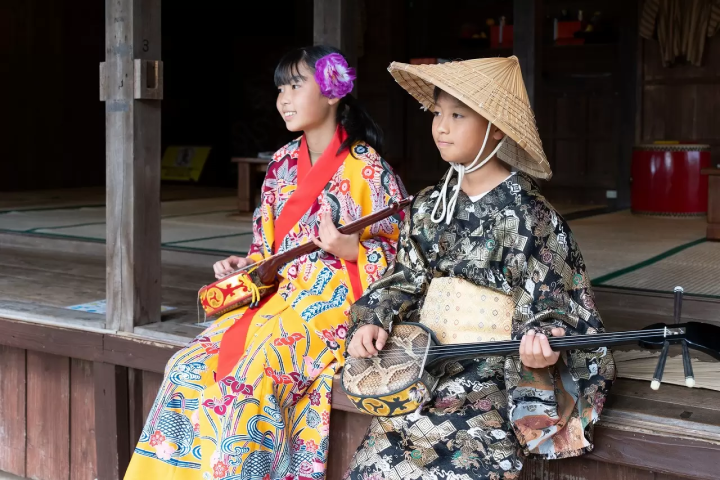
Photo by Pixta
Musicians play the sanshin by attaching a claw-like pluck to the end of their fingers, rather than using the rectangular pick used for the shamisen. Said to be over 600 years old and originating from China, the sanshin has deep roots in Okinawan culture and has been used throughout history to convey stories to the island's inhabitants, in cultural performances, and in traditional Okinawan music.
The instrument is a symbol of Okinawan culture and is frequently featured in various cultural events in Okinawa. The unique sound of the Sanshin captivates its listeners, drawing them into delightful stories filled with wonder and charm.
6. Kokyu
Known as a Japanese spiked fiddle, the kokyu is a tall, thin instrument with a square wooden base wrapped in stretched animal skin. Similar to a violin, the instrument is played by sliding a bamboo bow with horsehair across its strings.
Although the sound effects resemble those of a violin, several differences distinguish the kokyu from its counterpart. Besides the size and shape of the body, the kokyu has only three strings (sometimes four) and is played with the palm of the hand facing towards the body.

Photo by AC Photos
Additionally, the kokyu can be played standing up by attaching a string around one's waist, but it is commonly played sitting down, with the instrument resting on one's lap. The instrument's head is similar to a shamisen with three large tuners, but it can be easily differentiated without the bow by its long pointed rest at the base of the body. The kokyu produces high-pitched tones yet can convey a range of emotions, including sorrowful songs.
7. Sho
The sho is an incredible wind instrument, played similarly to a flute. The musician produces sound by blowing air through the reed and manipulating their fingers across the instrument's holes to play different pitches. Uniquely, the instrument resembles the pipes found in church pipe organs, featuring 17 bamboo pipes of various sizes arranged in a triangular shape, making it not only impressive to hear but also visually striking.

Photo by Pixta
Within each pipe resides a bronze reed that produces the sound of the individual pipe when air interacts with it. If you have visited Japan or reside there, you have likely heard this sound while strolling through a temple or participating in a shrine's spiritual ceremony. The instrument is commonly used in Buddhist temples for meditation and sacred rituals.
The sho has a long history in Japan and, similar to the kou, it dates back to the Nara period (710 - 784). To this day, the sho remains an essential part of Japanese culture, featured in sacred events, meditation practices, gagaku (ancient court music), and more recently, in contemporary modern music.
8. Tsuzumi Hand Drum
The tsuzumi is a Japanese hand drum consisting of an hourglass-like wooden tube with stretched animal skin covering each end of the instrument, creating a hollow chamber that reverberates to produce its iconic "po" sound.
This drum can be easily distinguished from taiko drums for several reasons. The tsuzumi's sounds are typically higher in pitch, and the instrument is played by striking one hand against the base rather than using drumsticks. Tsuzumi drums can also be carried, with the largest ones able to rest on a person's shoulder. In contrast, taiko drums are often so large and heavy that they are mounted to a frame or placed on the ground, immobile unless moved by pushing a float to which they are attached.
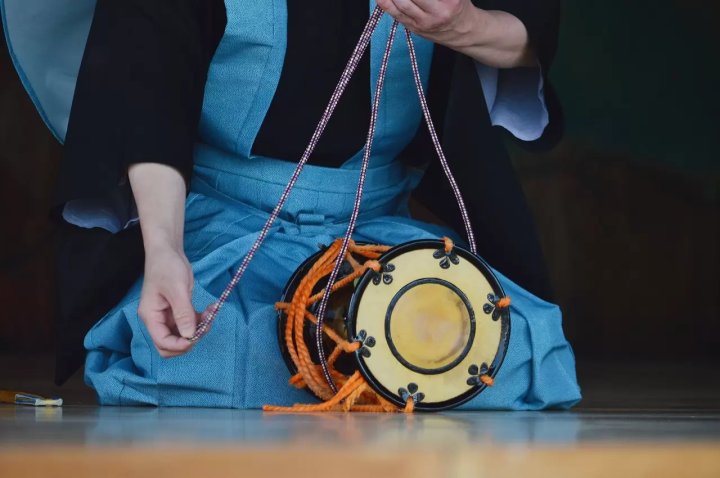
Photo by Pixta
The tsuzumi comes in two main types: the otsuzumi, carried on the left shoulder with one hand stabilizing it while the other hand strikes it (a moderately sized drum), and the kotsuzumi, a smaller drum played using two hands, producing a high-pitched sound when struck.
Musicians can create different tones by striking various parts of the drumhead, as demonstrated in the accompanying video. The tsuzumi is frequently observed in Japanese traditional performing arts like Noh theater, Kabuki, and Kagura, where it is used by characters to accentuate their emotions and dialogue.

Kanazawa, a city famous for its vibrant Noh theater culture, is known for its Tsuzumi Gate, a gate-like structure inspired by the shape of a tsuzumi, which is located in from of Kanazawa Station.
Read also
9. Shinobue
A simple yet ingenious design, the shinobue sings to the hearts of those who hear its melodies! This bamboo flute is often heard in emotional soundtracks, music related to Japanese anime, and films, creating incredibly clear melodies that soothe the soul.
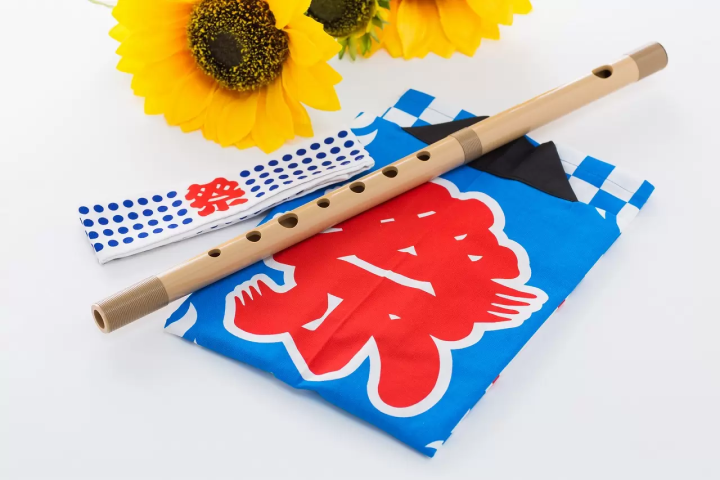
Photo by Pixta
Musicians hold the flute to the side of their face and blow gently into the mouthpiece to pass air through the pipe holes. By covering and uncovering these holes along the flute's body, players can produce a variety of tones and effects.
The shinobue can be found in various music genres, including contemporary compositions, festival music, and traditional folk music. Bamboo flutes have existed in Japan since ancient times, evolving and refining over centuries. While the exact origins of the shinobue are not documented, it is believed to have been in use as early as the 8th century in Japan.
10. Biwa Lute
Associated with the goddess Benten, the biwa is an instrument often depicted in murals, statues, and more within the serene shrines dedicated to this goddess, holding significant importance in Japanese storytelling and legends.
This instrument is a large wooden pear-shaped lute adorned with four, sometimes five, silk strings. Japan features two types of biwa: the Gagaku Biwa, utilized in epic tales like the Tale of Heike and in Gagaku performances, and the Satsuma Biwa, a smaller variant primarily employed in folk tales and Rokyoku songs.
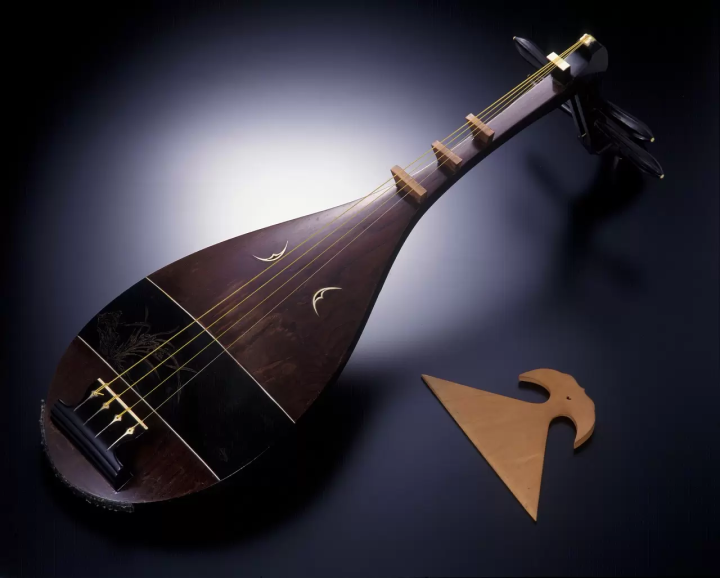
Photo by Pixta
An ancient instrument, the biwa has evolved as an art form since its introduction in 7th-century Japan. Presently, there exist diverse playing styles for the instrument. Musicians generate a wide range of music by using a large plectrum called a bachi to pluck, strum the strings, and tap on the wooden base. The sound of the biwa resonates in Japanese traditional music and has also found its way into modern and contemporary music in recent years.
FAQ
What is the traditional instrument of Japan?
The traditional instrument of Japan that is perhaps most emblematic of its musical heritage is the shamisen. The shamisen is a three-stringed musical instrument with a long neck and a small, rectangular body covered in skin. It is plucked with a plectrum called a "bachi" to produce a distinct, twangy sound. The shamisen is widely used in traditional Japanese music genres such as min'yo (folk music), nagauta (a traditional narrative music style), and kabuki theater. This instrument plays a vital role in various traditional Japanese performances and is deeply intertwined with the country's cultural identity.
What is the 13 instrument in Japan?
Traditional Japanese music encompasses a diverse array of sounds created by a variety of instruments. Central to this musical heritage are 13 key instruments, each contributing its own distinctive timbre and character. From the twang of the shamisen's strings to the soothing melodies of the koto, the haunting tones of the shakuhachi, and the powerful rhythms of the taiko drums, these instruments form the essence of traditional Japanese music. The biwa, fue, and hichiriki add further depth and complexity, while the tsuzumi drums and kokyu string instrument offer unique textures to performances. Completing this ensemble are instruments like the sō, hyoshigi, kane, and Nohkan, each playing a vital role in different cultural contexts, from traditional court music to folk songs and theatrical performances. Together, these instruments form the backbone of Japan's rich musical tapestry, reflecting its cultural depth and diversity.
What is the most popular instrument in Japan?
In Japan, one of the most popular and culturally significant instruments is the koto. The koto is a traditional Japanese stringed instrument with a history dating back centuries. It is known for its graceful sound and ability to evoke a wide range of emotions. The koto has a distinctive appearance, with a long, rectangular body and 13 strings that are plucked with finger picks. This instrument is widely used in various music genres, including classical, folk, and contemporary compositions.
The koto holds a special place in Japanese culture, being featured prominently in traditional performances, cultural ceremonies, and modern music compositions. Its versatile nature allows it to adapt to both traditional and contemporary styles, making it a beloved instrument among musicians and audiences alike. The koto's melodic and expressive qualities have helped it become one of the most recognizable and cherished musical instruments in Japan.
What instrument do samurai play?
Samurai in feudal Japan were warriors who practiced a variety of arts and disciplines, including music. One instrument that was associated with the samurai class and was commonly played by them was the shakuhachi.
The shakuhachi is a traditional Japanese bamboo flute known for its deep, meditative tones. Samurai warriors often practiced shakuhachi music as a form of meditation and spiritual discipline to cultivate inner peace, focus, and mindfulness. Playing the shakuhachi was not only a hobby for samurai but also a way to develop mental and emotional strength, which could be beneficial in their martial training and daily lives.
The shakuhachi's serene sound and connection to Zen Buddhism made it a popular choice among the samurai for its ability to foster introspection and a sense of tranquility. Playing this instrument allowed samurai to find moments of stillness and contemplation amidst the rigors of their warrior lifestyle.
What is the Japanese native instrument?
The koto is often considered the quintessential traditional and native instrument of Japan. The koto is a stringed musical instrument that dates back to ancient times in Japan and has deep roots in Japanese culture and history.
Characterized by its long, narrow body and 13 strings, the koto is played by plucking the strings with picks worn on the thumb and index fingers. It produces a rich and resonant sound that is integral to various styles of traditional Japanese music.
The koto has been a significant part of Japanese musical traditions for centuries, featuring prominently in genres such as classical court music (Gagaku), folk music (Min'yo), and contemporary compositions. Its distinct timbre and expressive capabilities make it a versatile and beloved instrument that embodies the essence of Japanese musical artistry and cultural heritage.
What is the national instrument of Japan?
The koto is often regarded as Japan's national instrument. This traditional Japanese stringed instrument has a rich history and cultural significance, making it a symbol of Japan's musical heritage. The koto's elegant appearance, melodic tones, and deep roots in Japanese traditional music have contributed to its status as a national symbol of musical artistry and cultural identity.
What instrument do geishas play?
Geishas, traditional Japanese entertainers known for their skills in performing various arts such as music, dance, and poetry, often play the shamisen. The shamisen is a traditional three-stringed musical instrument that is fundamental to geisha performances. Geishas use the shamisen, along with their captivating vocals, to accompany dances, storytelling, and other artistic expressions during their performances.
The shamisen's twangy sound and expressive capabilities lend themselves well to the subtle nuances and emotions conveyed in traditional Japanese arts. Geishas master the art of playing the shamisen to create an enchanting atmosphere and enhance the overall aesthetic experience for their audience, showcasing their talent and dedication to preserving and promoting Japan's cultural heritage through music and performance.
Explore the World of Japanese Musical Instruments
Japanese traditional music is a fascinating world on its own serving as a source of delight and inspiration for contemporary music, too. If you have the chance, do try to learn how to play one of these instruments - it might open the door to a new range of sound and music experiences for you!
Read also
Main image by Pixta
Assistant editor at MATCHA since 2023, Kate is a photographer who enjoys traveling Japan's hidden gems and adventuring off the beaten path. Living in Japan since 2018, she has traveled across different areas of Japan. From indulging in Aomori’s apple pies and fiery festivals to exploring the quaint charm of Nagasaki’s cat-filled streets she is always searching for new areas full of atmospheric beauty, festivals, and seasonal events to capture on camera.










![[Kabuki and cherry blossoms] Enjoy Japanese culture and cherry blossoms! Tourist spots & souvenirs summary](https://resources.matcha-jp.com/resize/200x2000/2024/03/27-175449.webp)




























![[Coupon Available] Attention Overseas Winter Sports Fans! Nagano's Sports Depot Has Evolved](https://resources.matcha-jp.com/resize/720x2000/2026/01/05-254819.webp)
![[2 hours from Tokyo ] 10 Quiet and Breathtaking Views of Mount Fuji in Yamanashi Hokuto City , Yamanashi - Part 2](https://resources.matcha-jp.com/resize/720x2000/2025/12/16-253037.webp)